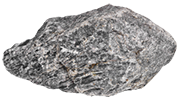
Horniny
Roches
vznik hornin
genèse f des roches
ʒənεz de ʀɔʃ
zvětrávání/eroze hornin
érosion f des roches
eʀozjɔ̃ de ʀɔʃ
hornina
roche f
ʀɔʃ
magmatická/vyvřelá hornina, vyvřelina
roche f éruptive/ignée
ʀɔʃ eʀyptiv/iɲe
metamorfovaná/přeměněná hornina
roche f métamorphique
ʀɔʃ metamɔʀfik
usazená hornina, usazenina
roche f sédimentaire
ʀɔʃ sedimɑ̃tεʀ
hlubinná/intruzivní vyvřelina, plutonit
roche f d'intrusion
ʀɔʃ dε̃tʀyzjon
sopečná/vulkanická/výlevná hornina, vulkanit
roche f volcanique
ʀɔʃ vɔlkanik
matečná hornina
roche f mère
ʀɔʃ mεʀ
krystal
cristal m
kʀistal
složení
composition f
kɔ̃pozisjɔ̃
struktura
structure f
stʀyktyʀ
pevná/nezpevněná hornina
roche f solide/meuble
ʀɔʃ sɔlid/mœbl
(přírodní) kámen
pierre f (naturelle/non taillée)
pjεʀ (natyʀεl/nɔ̃ taje)
písek
sable m
sɑbl
(hrubý) písek, drť
gros sable m
gʀo sɑbl
jemný písek
sable m fin
sɑbl fε̃
štěrkopísek
gravier m sableux
gʀavje sɑblø
štěrk
gravier m
gʀavje
jíl
argile f
aʀʒil
hlína
terre f , argile f
tεʀˌ aʀʒil
Půda
Sol
(skalní) podloží
soubassement m , substrat m rocheux
subɑsmɑ̃ˌ sypstʀa ʀɔʃø
(půdní) podloží
sous-sol m
susɔl
půda, země
sol m , terre f
sɔlˌ tεʀ
hlína
terre f
tεʀ
černozem
tchernoziom m , terre f noire
tʃεʀnɔzjomˌ tεʀ nwaʀ
hnědozem
terre f brune, sol m brun
tεʀ bʀynˌ sɔl bʀœ̃
ornice
couche f arable
kuʃ aʀabl
orná půda
terre f arable
tεʀ aʀabl
humus
humus m
ymys
kamenitá půda
sol m pierreux, terre f pierreuse
sɔl pjeʀøˌ tεʀ piεʀøz
písčitá půda
sol m sableux, terre f sableuse
sɔl sɑbløˌ tεʀ sɑbløz
vápnitá půda
sol m /terre f calcaire
sɔl /tεʀ kalkεʀ
jílovitá půda
sol m argileux, terre f argileuse
sɔl aʀʒiløˌ tεʀ aʀʒiløz
jíl
argile f
aʀʒil
podzolová půda
podzol m , podzosol m , sol m podzolique
pɔdzɔlˌ pɔdzɔsɔlˌ sɔl pɔdzɔlik
rašelina
tourbe f
tuʀb
úrodná půda
terre m fertile/féconde, sol m fertile/fécond
tεʀ fεʀtil/fekɔ̃dˌ sɔl fεʀtil/fekɔ̃
neúrodná půda
terre m infertile/inféconde, sol m infertile/infécond
tεʀ ε̃fεʀtil/ε̃fekɔ̃dˌ sɔl ε̃fεʀtil/ε̃fekɔ̃
Druhy hornin
Types de roches
žula
granit m
gʀanit
rula
gneiss m
gnεs
čedič
basalte m
bazalt
vápenec
calcaire m
kalkεʀ
pískovec
grès m
gʀε
křída
craie f
kʀε
mramor
marbre m
maʀbʀ
břidlice
schiste m
ʃist
svor
micaschiste m
mikaʃist
dolomit
dolomie f
dɔlɔmi
rohovec
silex m corné
silεks kɔʀne
křemenec, kvarcit
quartzite m
kwaʀtsit
bauxit
bauxite f
boksit
jílovec
argilite f
aʀʒilit
pemza
ponce f
pɔ̃s
slepenec
conglomérat m
kɔ̃glɔmeʀa
aglomerát
agglomérat m
aglɔmeʀa
